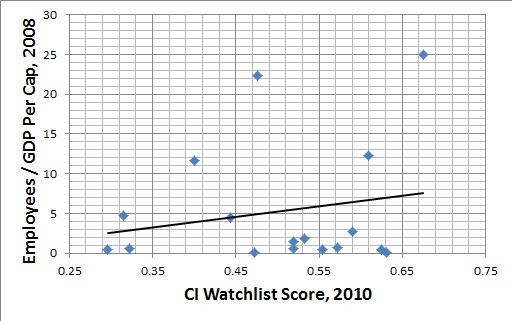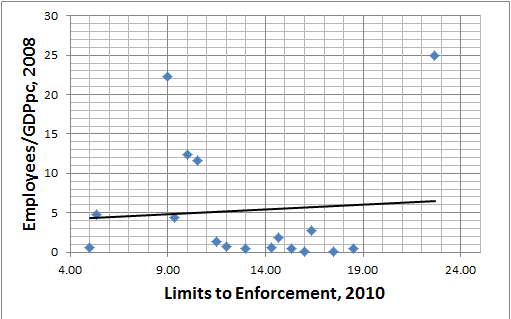 The copyright industries hire a lot of people, and employment figures are often used to argue for stronger protection for rightholders. But do the industries in countries with stronger protection for rightholders hire more people than the same industries in countries with limits on the scope and enforcement of copyright? Do countries with more robust limitations and exceptions to copyright have fewer ‘copyright industry’ jobs?
The copyright industries hire a lot of people, and employment figures are often used to argue for stronger protection for rightholders. But do the industries in countries with stronger protection for rightholders hire more people than the same industries in countries with limits on the scope and enforcement of copyright? Do countries with more robust limitations and exceptions to copyright have fewer ‘copyright industry’ jobs?
One thing that muddles an examination of these questions is the awkward amalgamation of “copyright industries.” Frequently cited reports on employment by these industries include many that rely on the existence on limitations and exceptions. The CCIA studies on “fair use” industries and the copyright chapter of the recent USPTO Industries in Focus study list many of the same industries. (I asked Stephen Siwek for the exact industries tallied up in his most recent IIPA study, but he declined to share.)
So a good starting point is to look at a subset of the traditional “copyright industries,” publishers. In this post I take cross country survey data showing which countries have more limitations and exceptions to copyright, and compare it to publishing industry employment data from the UN. The data shows that the publishing industry does not necessarily provide more jobs in countries with relatively stricter copyright laws.
Consumers International survey data on copyright user rights
From 2010 through 2012, Consumers International published the A2K Watchlist, described as “a global survey that rates national copyright laws and enforcement practices from the perspective of how well they promote access to knowledge for consumers, by allowing them fair access to the fruits of their society’s culture and science.” The 2010 Watchlist is closest in time period to the available UN data, and it covers 34 countries.
The A2K Watchlist is constructed by surveying experts on copyright (and related) laws in their countries. The 2010 survey consisted of 55 questions which are grouped into eleven categories of limitations and exceptions to copyright, which relate to: copyright scope and duration; home users; education; online users; content creators; the press; libraries; disabled users; public affairs; the freedom to share; and enforcement. Each category is given a raw numerical score, and they are combined into an overall index. The questions are available here.
One can use the overall index as a score of user rights, or one can take the disaggregated parts, and compare this to employment figures.
UNIDO Data on publishing industry employment
The UN Industrial Development Organization (UNIDO) publishes cross country industry-level employment data in time series ending in 2009, but the dataset has missing data for many countries and industries, especially for the last year in the series. Nonetheless, one can find publishing industry data on value added and employment from 2008 (or when that is unavailable, 2007) for a decent number of countries. The “publishing industry” here is defined as firms classified by the three-digit International Standard Industry Classification (ISIC Rev. 3) code 221. This includes publishers of “books, brochures, musical books, newspapers, journals, periodicals and recorded media.” UNIDO collects the data from national governments and compiles it into its INDSTAT database.
There are 17 countries which are included in Consumers International’s 2010 Watchlist, and for which there is UNIDO data on employment. The sample is small, but it includes data from lower-middle, upper-middle and high income countries.[1] Before making a comparison, we control for a proxy of wealth, measured by 2008 GDP per capita (data from the World Bank).
For these 17 countries we graph employment divided by GDP per capita against the overall CI score, its component on limits to the scope and duration of copyright, and limits to enforcement. For each of these, we see a lot of variation, but a positive trend.
Positive correlations between the strength of user rights protections and publishing industry employment is not meant to show that strong user rights leads to more employment in the publishing industry. However, the data does show that once we control for a country’s wealth, publishers in countries where copyright law is relatively balanced are doing at least as well, if not better than publishers in countries with stricter copyright regimes.
————————–
The countries in the sample are Brazil, Chile, Fiji, India, Indonesia, Israel, Jordan, Lebanon, Malaysia, Morocco, New Zealand, South Africa, Spain, Sweden, Ukraine, United Kingdom, and Vietnam.







